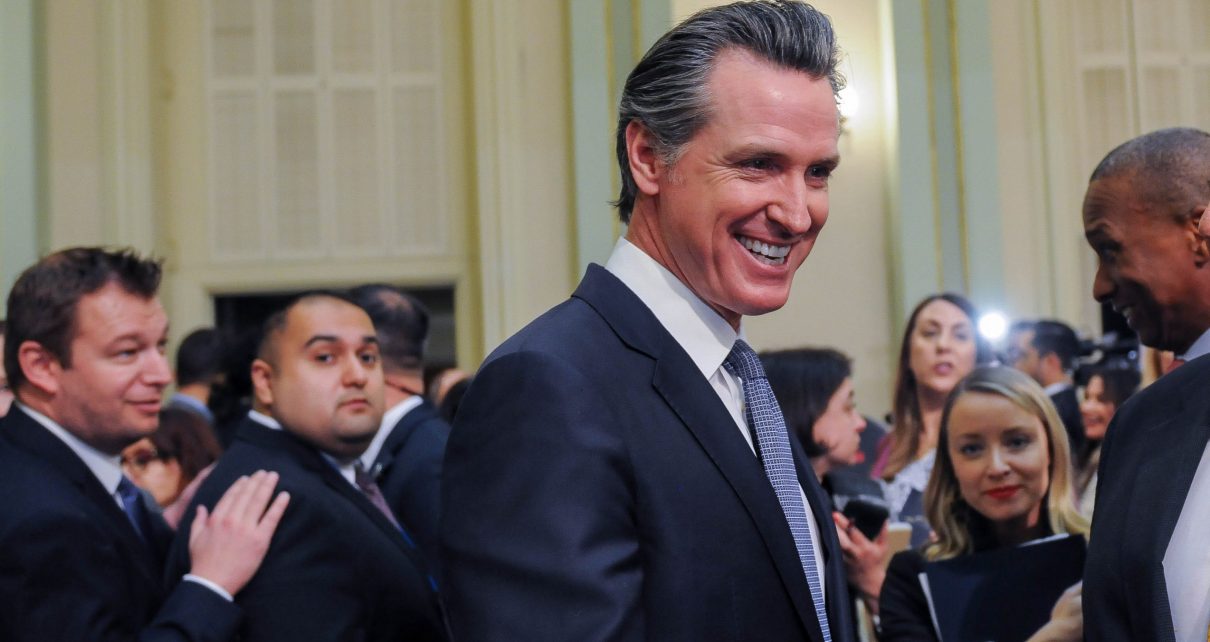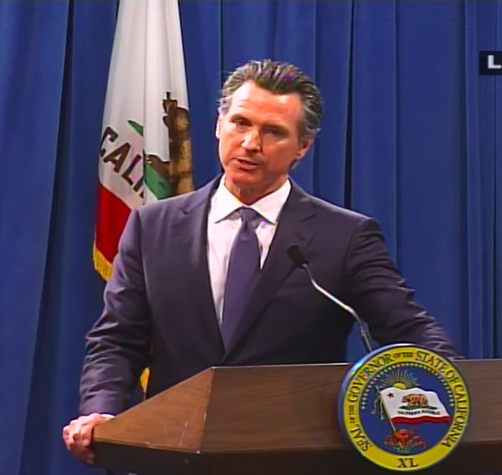
Governor Gavin Newsom. (Photo: Kevin Sanders for California Globe)
Overview of Gov. Newsom’s Retroactive ‘Revenue Raising Proposals’ in the May Budget Revise
Proposal: suspension of net operating loss deduction, cap on the use of business tax credits
By Chris Micheli, May 24, 2020 4:01 pm
As part of his May Budget Revision (the “May Revise”), Governor Newsom proposed several “revenue raising solutions.” The Governor’s Department of Finance has just released the proposed budget trailer bill language to implement this revenue raisers. The first proposal is a 3-year suspension of the net operating loss (NOL) deduction and the second proposal is a 3-year cap on the use of business tax credits. The following is an explanation of the proposed budget trailer bill language.
NOL Suspension
The proposed trailer bill would add a new code section to both the personal income tax (PIT) and bank and corporation (B&C) tax law sections of the California Revenue & Taxation Code (CRTC). In the PIT law section, proposed new Section 17276.23 would be added as follows:
Subdivision (a) provides that “notwithstanding” all of the current law CRTC sections dealing with the NOL deduction, “no net operating loss deduction shall be allowed for any taxable year beginning on or after January 1, 2020 and before January 1, 2023” (thereby covering three tax years). This section applies to both a loss and a carryover of a loss.
Subdivision (b) provides that the carryover period is extended for each year that the deduction is suspended. For example, for a loss generated in 2019, the taxpayer will have three additional years added to the carryover period because the taxpayer cannot use them for the next three years.
Subdivision (c) provides the following exemptions: (1) taxpayers with net business income of less than $1 million for the taxable year. “Business income” is defined as income from a trade or business; income from rental activity; or, income attributable to a farming business. (2) taxpayers with modified adjusted gross income of less than $1 million for the taxable year.
In the B&C tax law section, proposed new Section 24416.23 would be added as follows:
Subdivision (a) provides that “notwithstanding” all of the current law code sections dealing with the NOL deduction, “no net operating loss deduction shall be allowed for any taxable year beginning on or after January 1, 2020 and before January 1, 2023” (thereby covering three tax years). This applies to both a loss and a carryover of a loss.
Subdivision (b) provides that the carryover period is extended for each year that the deduction is suspended. For example, for a loss generated in 2019, the taxpayer will have three additional years added to the carryover period because the taxpayer cannot use them for the next three years.
Subdivision (c) provides the following exemption: taxpayers with income subject to tax of less than $1 million for the taxable year.
Tax Credit Usage Limitation
The proposed trailer bill would “limit business incentive credit use to $5 million per year.” This language contains four CRTC section changes. First, in the sales and use tax law section, existing CRTC Section 6902.5 would be amended as follows:
Existing law allows a claim for refund for specified taxpayers who claim the film tax credit and who have been issued a credit certificate by the California Film Commission. The first amendment would add new subdivision (c)(1) to read:
(c) (1) The limitations under Section 17039.3 and 23036.2 shall not apply to the credit amount eligible for an irrevocable election under this Section. (2) For returns filed on or after January 1, 2020 and before January 1, 2023, the credit amount eligible for an irrevocable election under subdivision (b) shall not exceed five million dollars ($5,000,000) per calendar year. While the first clause exempts this claim for refund from the general $5 million cap applicable to tax credit usage, the second clause creates a standalone $5 million cap per calendar year.
The second amendment would add new subdivision (j) to read: (j) The amendments made to this section by the act adding this subdivision shall not apply to irrevocable elections made before the enactment date of the act adding this subdivision. This provision excludes irrevocable elections for the sales/use tax claim for refund from the credit cap.
Second, in the insurance tax law section, existing CRTC Section 12206 would be amended. This code section deals with the state’s low-income housing tax credit. The amendment would add new subdivision (a)(4) to read:
(4) For each taxable year beginning on or after January 1, 2020, and before January 1, 2023, the amount allowed as a credit against tax (as described by Section 12201), including the carryover of any credits under this section, shall not exceed five million dollars ($5,000,000). This section creates a standalone cap of $5 million for the low-income housing tax credit that insurers can claim.
The third amendment would add new Section 17039.3 to the CRTC, which is in the personal income tax law, as follows:
17039.3. (a) Notwithstanding any provision of this part or Part 10.2 (commencing with Section 18401) to the contrary, for taxpayers not required to be included in a combined report under Section 25101, Section 25110, or authorized to be included in a combined report under Section 25101.15, for each taxable year beginning on or after January 1, 2020, and before January 1, 2023, the total of all business credits otherwise allowable under any credit under any provision of Chapter 2 (commencing with Section 17041), including the carryover of any business credit under a former provision of that chapter, for the taxable year shall not reduce the “net tax,” as defined in Section 17039, by more than five million dollars ($5,000,000). This section caps the use of all business credits to $5 million per tax year, for three years, for those not required to be included in a combined report.
(b) Notwithstanding any provision of this part or Part 10.2 (commencing with Section 18401) to the contrary, for taxpayers required to be included in a combined report under Section 25101, Section 25110, or authorized to be included in a combined report under Section 25101.15, the total of all business credits otherwise allowable under any provision of Chapter 2 (commencing with section 17041), including the carryover of any business credit under a former provision of that chapter, by all members of the combined report shall not reduce the aggregate amount of “tax” (as defined in Section 23036) of all members of the combined report by more than five million dollars ($5,000,000) for each taxable year beginning on or after January 1, 2020, and before January 1, 2023. This section caps the use of all business credits to $5 million per tax year, for three years, for those required to be included in a combined report.
(c) For purposes of this section, “business credit” means a credit allowable under any provision of Chapter 2 (commencing with Section 17041) other than the following credits: (1) The credit allowed by Section 17052 (relating to credit for earned income). (2) The credit allowed by Section 17052.1 (relating to credit for young child). (3) The credit allowed by Section 17052.6 (relating to credit for household and dependent care). (4) The credit allowed by Section 17052.25 (relating to credit for adoption costs). (5) The credit allowed by Section 17053.5 (relating to renter’s tax credit). (6) The credit allowed by Section 17054 (relating to credit for personal exemption). (7) The credit allowed by Section 17054.5 (relating to credit for qualified joint custody head of household and a qualified taxpayer with a dependent parent). (8) The credit allowed by Section 17054.7 (relating to credit for qualified senior head of household). (9) The credit allowed by Section 17061 (relating to refunds pursuant to the Unemployment Insurance Code). This section provides an exemption for nine credits as specified above.
(d) Any amounts included in an election pursuant to Section 6902.5, relating to an irrevocable election to apply credit amounts under Sections 17053.85, 17053.95, 17053.98, 23685, 23695, or Section 23698 against qualified sales and use tax, as defined in Section 6902.5, are limited to five million dollars ($5,000,000) per taxable year, but are not included in the five million dollar ($5,000,000) limitation set forth in subdivision (a) or (b). This section is a separate cap of $5 million per tax year for the film tax credit.
(e) The amount of any credit otherwise allowable for the taxable year under Section 17039 that is not allowed due to application of this section shall remain a credit carryover amount under this part. This section provides that credits not allowed during the three-year limitation can be carried over.
(f) The carryover period for any credit that is not allowed due to the application of this section shall be increased by the number of taxable years the credit or any portion thereof was not allowed. This section provides that, for each tax year a credit is not allowed, it can be carried over the same number of year(s) that it was not allowed.
(g) Notwithstanding anything to the contrary in this part or Part 10.2 (commencing with Section 18401), the credits listed in subdivision (b) shall be applied after any business credits, as limited by subdivision (a), are applied. This section has an incorrect reference – subdivision (b) should actually be subdivision (c) – but is intended to allow the nine credits listed in subdivision (c) to still be utilized by taxpayers. They will claim those any of those credits after they claim up to the maximum of $5 million in business credits.
(h) Chapter 3.5 (commencing with Section 11340) of Part 1 of Division 3 of Title 2 of the Government Code does not apply to any standard, criterion, procedure, determination, rule, notice, or guideline established or issued by the Franchise Tax Board pursuant to this section. This section exempts any written issuances by the FTB from California’s Administrative Procedure Act.
The fourth amendment would add new Section 23036.3 to the CRTC, which is in the bank and corporation tax law. This section is identical to the new section in the personal income tax law set forth above as the third amendment. To understand the extend of the credit usage cap, the following is a listing of the business tax credits that are subject to the credit usage cap contained in this budget trailer bill:
CHAPTER 3.5. Tax Credits [Sections 23604 – 23698]
Sec. 23604 — Qualified enhanced oil recovery project credit
Sec. 23608 – Credit for transports of any agricultural products donated
Sec. 23609 – Research and development tax credit
Sec. 23610.5 — State low-income housing tax credit
Sec. 23621 – Hiring credit
Sec. 23624 — Joint venture program through agreement with the Director of Corrections.
Sec. 23626 – Hiring credit for employees in designated census tracts
Sec. 23630 — Qualified contributions approved for acceptance by Wildlife Conservation Board
Sec. 23636 – Joint Strike Fighter hiring credit
Sec. 23642 – Expenditures to provide access to disabled individuals
Sec. 23685 — Qualified expenditures for production of qualified motion pictures
Sec. 23687 – Credit for taxpayer contributions to the College Access Tax Credit Fund
Sec. 23688.5. – Credit for qualified donation items to a food bank
Sec. 23689 – GO-Biz hiring tax credit
Sec. 23691 — Qualified rehabilitation expenditures with respect to a certified historic structure
Sec. 23695 – Expenditures for the production of a qualified motion picture
Sec. 23698 — Expenditures for the production of a qualified motion picture
On May 21, both the Assembly Budget Subcommittee # 4 and the Senate Budget Subcommittee # 4 heard presentations by the Department of Finance and the Legislative Analyst Office regarding these revenue raising proposals. The budget subcommittees also took limited public comment. The Assembly did not take any formal action, while the Senate held the items open, perhaps for a vote in the next week or two.
Both of these provisions, if agreed to by the Legislature, will be placed in a budget trailer bill (which has not been identified at this point). Because these provisions raise revenue from taxpayers, they will require a 2/3 majority vote in both the Assembly and Senate. These two tax law changes are estimated to raise nearly $2 billion each during their first year of implementation.
If adopted, they will apply retroactively to January 1, 2020 and taxpayers claiming an NOL deduction and/or business tax credits will need to make adjustments to their quarterly tax payments to recognize the loss of the deduction and/or the limitation on credit usage.
- Health Insurance for Child Support - December 18, 2025
- Sale or Disposal of Unclaimed Property - December 18, 2025
- Modifying or Terminating Child Support Orders - December 17, 2025





One thought on “Overview of Gov. Newsom’s Retroactive ‘Revenue Raising Proposals’ in the May Budget Revise”